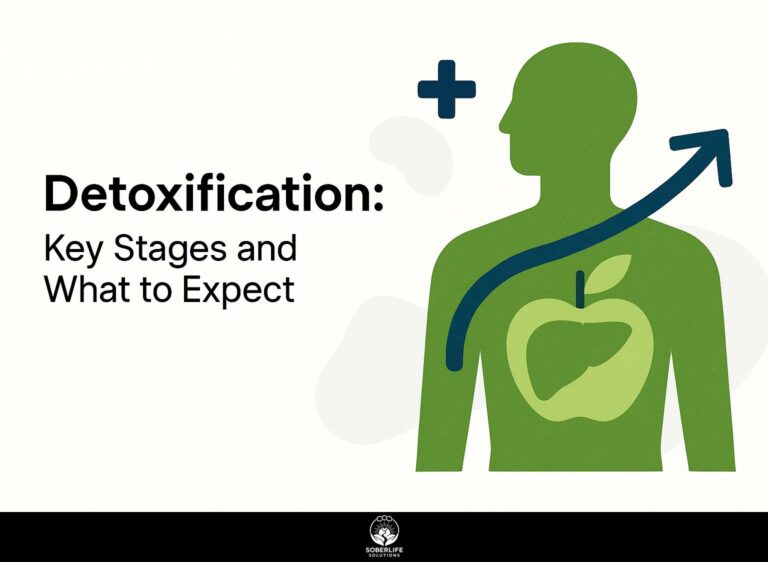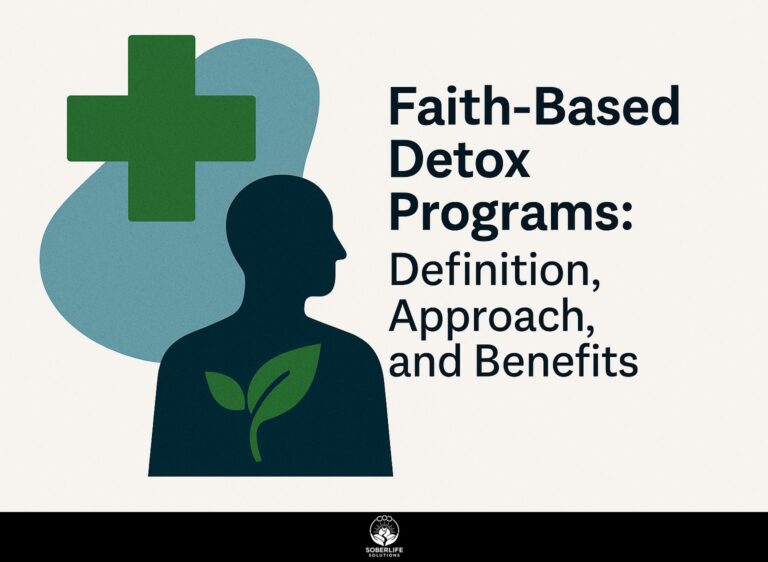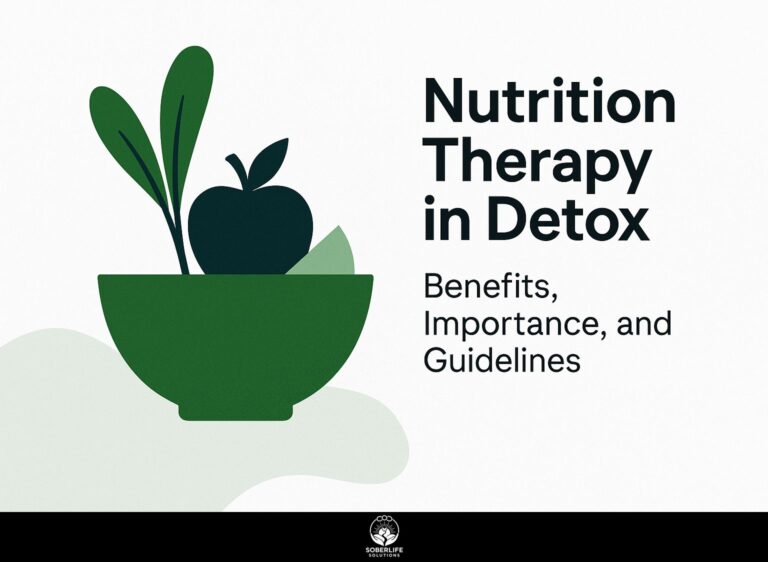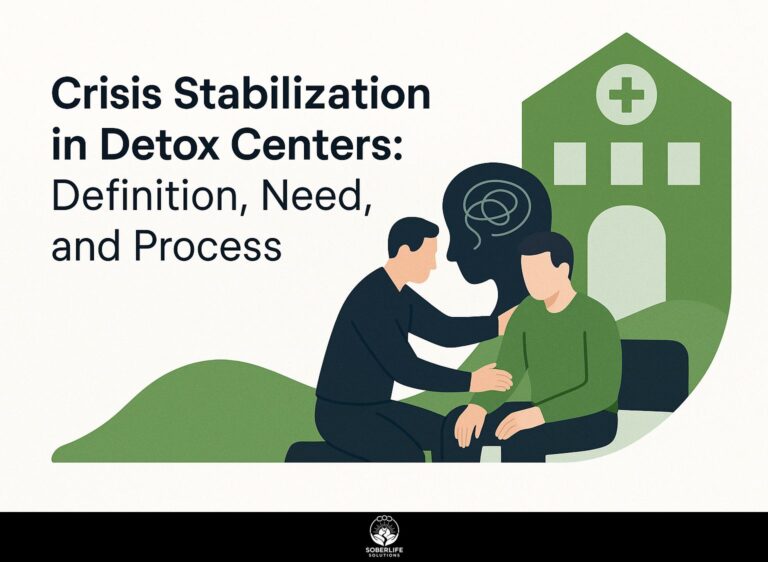How to Access Emergency Detox Services: Guide for Immediate Help

When dealing with addiction to alcohol, tobacco, or illegal drugs, getting immediate detox services can be an important step toward getting better. Being aware of your options and recognizing signs of drug abuse are important for your health. This guide provides quick assistance on how to find detox services, giving you the tools and information needed to manage your addiction recovery. Discover the path to recovery today!
Key Takeaways:
Recognizing the Need for Detox

Recognizing when detox is needed is important.
Starting treatment early can significantly help people recovering from addiction. Those interested in understanding the detailed process might find our discussion on medically monitored detox insightful.
Signs of Substance Abuse
Common signs of substance abuse include drastic changes in behavior, health deterioration, and withdrawal symptoms such as anxiety and tremors.
Additional indicators of substance abuse encompass specific physical, psychological, and behavioral changes. Physically, individuals may experience noticeable weight fluctuations or poor hygiene, neglecting personal care.
Psychologically, people may experience changes in mood, increased secretive behavior, and make hasty decisions. Behaviorally, significant job or academic decline, along with legal issues like arrests, may emerge.
If you notice a person you care about distancing themselves from loved ones, it’s important to be compassionate and recommend they consult a professional. According to the Mayo Clinic, seeking timely help can significantly improve outcomes for individuals struggling with substance abuse.
When to Seek Help
Getting help is necessary if drug use results in repeated overdoses or if daily activities become unmanageable.
In such cases, it’s essential to contact local emergency services or your healthcare provider immediately.
For example, if someone has a seizure after using drugs or experiences severe withdrawal symptoms, these are urgent signs that they need detox help.
Use resources like the Substance Abuse and Mental Health Services Administration (SAMHSA) national helpline at 1-800-662-HELP, where trained professionals can provide guidance. According to a recent publication by SAMHSA, their helpline offers critical support for individuals facing substance abuse issues.
Remember, the sooner you act, the better the chances of recovery.
Types of Emergency Detox Services

Knowing the different kinds of emergency detox services is important for choosing the best treatment method for a person’s specific needs and situation. For guidance on selecting the most suitable facility, consider the criteria in our related callout about how to evaluate rehab and detox centers.
Inpatient Detox Programs
Inpatient detox programs offer round-the-clock medical care and an organized environment, making them appropriate for severe substance use cases.
These programs usually last from 7 to 14 days. For example, NewYork-Presbyterian’s Smithers Center offers a variety of services.
Patients undergo medical evaluations, receive individualized treatment plans, and have access to therapies like group counseling and cognitive-behavioral therapy.
Daily schedules often include planned meals, physical activity, and group meetings to help with recovery. The intensive monitoring helps manage withdrawal symptoms effectively, reducing the risk of complications.
Inpatient detox programs provide a supportive and safe setting that is important for people starting their path to sobriety.
Outpatient Detox Services
Outpatient detox services provide flexibility, allowing individuals to undergo treatment while maintaining their daily responsibilities.
These programs work well for people with milder addictions, providing organized sessions that usually run for three to five hours daily.
For example, a common approach is a 10- to 14-day regimen that includes individual therapy, group support meetings, and access to medical supervision if needed.
People often interact with counselors and join peer support groups, building a sense of community. The primary goal is to help people with daily challenges and stop setbacks, making sure they get the support they need.
How to Find Emergency Detox Services

Finding emergency detox services is an important part of recovery.
Resources are available locally and online to help individuals in crisis. In particular, medication-assisted recovery options can be invaluable; exploring such approaches, like those discussed in our Medication Assisted Recovery Anonymous: Meetings and Benefits, can provide additional support during the detox process.
Local Resources and Hotlines
Local resources such as emergency hotlines, like the SAMHSA National Helpline (1-800-662-HELP), offer immediate support and referrals to detox services.
Additional resources include the National Suicide Prevention Lifeline at 1-800-273-TALK, which connects individuals to trained counselors 24/7.
If you are in California, you can call the California Peer-Run Warm Line at 1-855-845-7415 for emotional support and help.
Local hospitals often have ER services specifically for addiction crises; contacting your nearest facility can guide you through immediate care options.
Consider reaching out to community organizations like Alcoholics Anonymous (AA) for supportive peer networks.
Online Directories
Websites like the Substance Abuse and Mental Health Services Administration list many detox centers and treatment choices.
- To make the most of these directories, begin by sorting the results based on details such as location, type of treatment, and facility ratings.
- Look for user reviews to gauge the experiences of former patients; this can guide you toward quality care. Pay attention to the accreditation status of the facilities listed, which often indicates adherence to standards.
- Save a few choices and contact them to ask about program details, availability, and if they accept your insurance. This focused method increases the likelihood of getting the right help.
Evaluating Detox Facilities

Checking detox centers is important to make sure people get care that is both safe and matches their specific needs. For a comprehensive understanding, follow the methodology in our step-by-step guide on evaluating rehab and detox centers, which outlines key criteria and helps identify potential red flags.
Accreditation and Licensing
Accreditation from organizations like the Joint Commission indicates that a detox facility meets specific quality standards and regulations.
To verify a facility’s accreditation, check its website for accreditation details or search the accrediting body’s database.
Key accrediting bodies include:
- The Substance Abuse and Mental Health Services Administration (SAMHSA)
- The National Committee for Quality Assurance (NCQA)
- The Commission on Accreditation of Rehabilitation Facilities (CARF)
Reputable accredited facilities such as Hazelden Betty Ford and Passages Malibu have consistently demonstrated high standards of care. Checking if a facility is accredited can greatly affect the quality of care and help given to those who need it. The benefits of accreditation extend beyond immediate service quality, impacting public health positively, as highlighted in the CDC’s analysis on accreditation impacts.
Staff Qualifications
The qualifications of staff at detox facilities significantly impact the quality of care, with trained professionals ensuring effective treatment approaches.
Key qualifications to consider include:
- Certifications: Look for professionals with credentials such as Certified Addiction Counselor (CAC) or Licensed Professional Counselor (LPC).
- Experience: Staff should have hands-on experience in addiction treatment, particularly in detox settings, to address cravings and withdrawal effectively.
- Multidisciplinary Teams: Make sure the facility has a variety of professionals, such as doctors, nurses, and experts in treating co-occurring disorders, who work together to offer complete care.
These elements work together to build a helpful setting that is essential for recovery.
Preparing for Detox

Good planning for detox can improve the process and results for people in this important part of recovery.
What to Bring
Bringing the right items to a detox facility can significantly improve comfort and ease during the treatment process.
Essential items include personal hygiene products such as toothbrushes, soap, and shampoo, which help maintain cleanliness and promote self-care.
Wearing loose sweats and comfortable shoes helps you move easily and stay relaxed. Don’t forget any prescribed medications and a few comforting personal items, such as a favorite book or journal.
Before packing, always check with the facility about their specific rules on allowed items, as some may have restrictions that you’re unaware of.
Understanding the Process
Knowing about the detox process, its steps, and possible withdrawal symptoms helps people get ready mentally and emotionally for treatment.
The detox process typically includes three major stages: medical evaluations, withdrawal management strategies, and therapy.
-
First, a detailed medical check-up is done to find any health risks and make a plan just for you.
-
Withdrawal management involves monitoring symptoms and providing medications as needed to ease discomfort. This can last from a few days to a few weeks, depending on the substance.
-
Cognitive behavioral therapy (CBT) is important because it helps people learn what causes their issues and find ways to deal with them, greatly improving the process of detoxification.
After Detox: Next Steps

Taking care of yourself after detox is important to keep improving. There are many ways to help people continue their recovery, including self-care habits that play a crucial role in maintaining sobriety (see also: Developing Self-Care Habits in Recovery).
Continuing Care Options
Continuing care options, including outpatient programs and treatment with medication, give important help for people after detox.
These options vary in structure and frequency. Outpatient programs typically involve sessions 1-3 times per week, focusing on individual counseling and group therapy.
For instance, Cognitive Behavioral Therapy (CBT) can help individuals recognize and combat harmful thought patterns. It’s important to use strategies to prevent relapse, like creating a support network and learning ways to cope, which can greatly lower the chance of relapse.
Regular check-ins with healthcare providers help individuals stay on course with their recovery process.
Support Networks
Joining support groups like [Alcoholics Anonymous](https://www.aa.org) or [SMART Recovery](https://www.smartrecovery.org) can be very helpful in recovery after detox.
These networks offer responsibility and a sense of belonging, which are essential for long-term sobriety.
For example, local Alcoholics Anonymous groups usually have weekly meetings. They provide a secure space where people can share their experiences and build relationships.
Community resources like therapist-led support groups or local wellness workshops can build further support and coping strategies.
Looking into platforms like Meetup can help you find local events that match your interests. Using these connections helps you recover and supports your personal development.
Frequently Asked Questions
What are emergency detox services and when should I access them?
Emergency detox services are facilities that offer immediate help for people experiencing severe and dangerous symptoms of drug or alcohol withdrawal. They should be accessed when a person is in immediate danger due to their substance use and requires immediate medical attention.
How do I know if I need emergency detox services?
If you have serious withdrawal symptoms like seizures, hallucinations, or suicidal thoughts, it is important to get emergency detox services. It’s important to use these services if you’ve had serious withdrawal symptoms before or if you’ve relapsed during detox previously.
How can I access emergency detox services?
The best way to access emergency detox services is by calling 911 or going to the nearest hospital emergency room. You can also reach out to a local addiction hotline or your regular doctor for help in finding the right resources.
What should I expect when accessing emergency detox services?
When you access emergency detox services, you will be evaluated by a medical professional to determine the best course of treatment. This may include receiving medications to manage your withdrawal symptoms, being monitored closely, and possibly being admitted to a detox facility for further care.
Are emergency detox services covered by insurance?
In most cases, emergency detox services should be covered by your health insurance. It is essential to check with your insurance provider beforehand to confirm coverage and any potential out-of-pocket costs.
What happens after I complete emergency detox services?
After completing emergency detox services, you will likely be referred to a treatment program to address the underlying causes of your addiction. It’s important to keep up with regular treatment and support to stay sober and lower the chance of relapsing.






